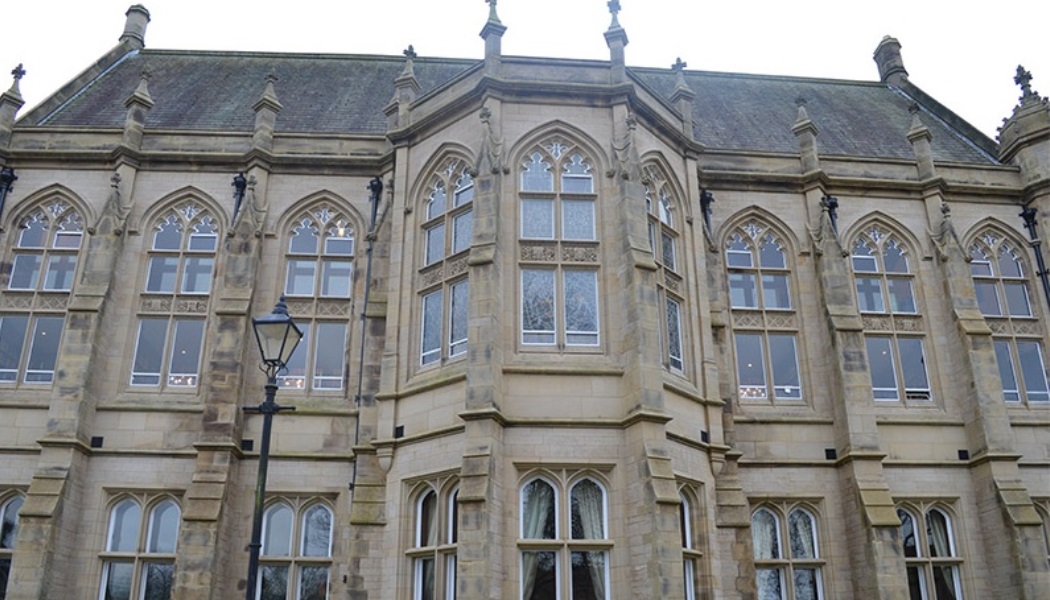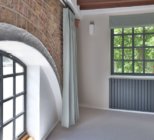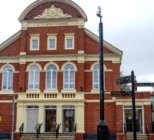Harris Manchester College is one of the constituent Colleges of the University of Oxford. It was established in 1757 as a college for Unitarian students and based in Warrington, prior to relocating to Oxford in 1893. It became a full college of the university in 1996, taking its current name to honour its predecessor the Manchester Academy and a benefaction by Lord Harris of Peckham.
The late Victorian buildings contain ornate wooden panelling, gothic revival architectural detailing and large stained-glass windows. With long-term construction works opposite the north side of the main building, the fragility of this Grade II Listed Building and its original features became evident, with noise and dust ingress a problem. Four rooms were affected: two meeting rooms, a student common room, and the Tate Library.
To remedy this, a new project – part of the College’s larger greening plans – was spearheaded by fellow librarian Sue Killoran, who set about finding means to reduce noise breakthrough and to increase energy efficiency by reducing wasted heat escaping through the draughty single glazed windows.

Secondary glazing was deemed the most appropriate solution. Selectaglaze was contacted to provide guidance on treatments, support in acquiring Listed Building Consent and subsequent advice on compliance with glazing requirements.
In total, 28 windows across the four different rooms required secondary glazing. Each room presented unique challenges and specific requirements.
In the two meeting rooms, Series 20 slimline vertical sliding units were installed; colour matched in a wood grain finish to complement and blend in with the wood panelling and reveals. They were glazed with 6.8mm acoustic glass and positioned to optimise the cavity, ensuring high levels of acoustic reduction, as well as providing access for cleaning and maintenance.
However, there was a quirky design element which had to be overcome so as not to compromise the installation and ensuing benefit. The window sills had inset heating grilles, meaning that if the secondary glazing was installed in a normal fashion the timber ground would have cut across the grille – allowing heat to seep into the cavity. Through the inclusion of an enlarged rebated timber, the secondary could be sealed around the full perimeter but still leave clear passage for air from the heating grill.

The Tate Library has 50 study desks and, until the secondary glazing was installed, provided users with earplugs to block out noise and gave out blankets during the Autumn and Winter months. The primary windows in this room are tall gothic arched windows, with three stained glass windows forming a main bay. They all had single glazed openings which were ineffective in preventing draughts or noise insulation.

To complement the interior décor and leaded casings, the timber sub frames and secondary glazing profiles were colour coated in 9005 Jet Black Matt. The timber was scribed on site and installed prior to the manufacture survey to ensure exact measurements were taken.
The gothic arches stand tall at 4.5 metres and have a mezzanine cutting them through the middle, which made the design and installation tricky. The portion of the window below the mezzanine was a Series 10 horizontal sliding unit. Stacked on top, in an area not requiring on-going access, were two Series 42 fixed lights. Above these, leading up to the spring point, was another Series 10, followed by three Series 42 curved fixed lights including reverse curving to follow the lines and details of the tracery at the head. Installed with 6.8 laminate glass and a generous cavity, the space is now quieter, cosier and provides UV protection to the Library books and manuscripts.










